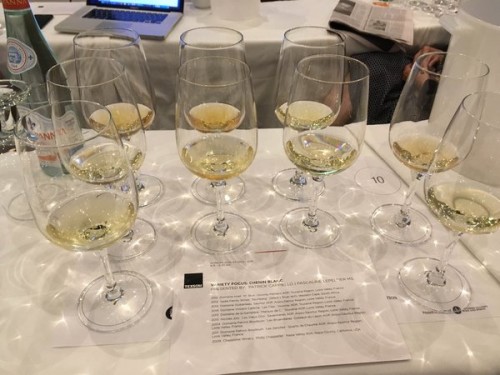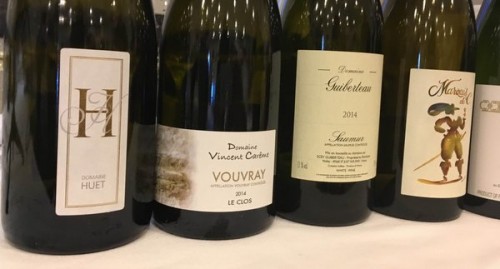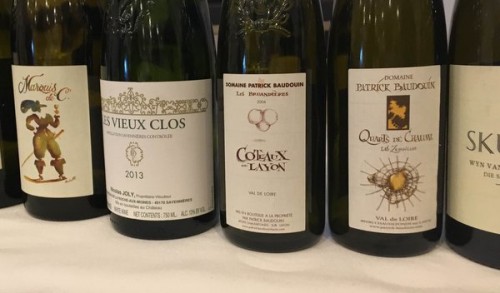
Patrick Cappiello and Pascaline Lepeltier presented this Chenin tasting at Texsom.
‘I deeply believe that Chenin is the best white grape in the world,’ says Pascaline, a very highly regarded sommelier. She’s been working in New York for the last eight years, but she grew up in the Loire, and is a keen evangelist for Loire Valley wines.
‘Loire is where you can understand the diversity of the grape better than anywhere else,’ she says. ‘The grape has an amazing potential and we should drink more Chenin.’
In New York, Chenin is becoming more popular. ‘In 2001 in wine lists in NYC there was virtually no Chenin Blanc,’ says Patrick. ‘Baumard and Huet were the only two you could get. When I started buying wines myself a lot of these producers weren’t even available. Pascaline has got everyone excited about it.’
But this masks a global decline in the plantings of Chenin. It’s really a grape that’s experiencing a tough time. In the Loire it’s really experienced a lot of problems. In the past, Loire Chenin was mostly sweet, and the increasing mechanization and industrialization of wine that took place in the 1950s-1970s resulted in lots of poor quality Loire Chenin, which in turn let to a decline in its fortunes.
Back in 1990 there were 65 000 hectares of Chenin, worldwide, but by 2014 this had fallen to 37000 ha. The current breakdown is 17933 ha in South Africa, 9728 ha in France (95% in Loire), 2630 ha in the USA and 2320 ha in Argentina.
Pascaline gave us a brief background to the variety. It was first mentioned by Rabelais in Gargantua in 1534, and its name is said to come from the monastery of Mont-Chenin, near Comery in Touraine. One of its parents is Savagnin. It is easy to grow and gives good yields. There were early migrations to the south west, Holland and South Africa, but it hasn’t spread all that much since then.
You can make every style of wine with this grape: very few grapes can manage this spectrum. High level bubbles, dry, off dry, sweet, very sweet. Riesling is the only other variety that can do this sort of variety.
Chenin produces great sweet wines because it takes botrytis well, and that’s one of the reasons it thrived and persisted. The history of Chenin in the Loire is mostly one of making sweet wines, and dry wines are a relatively recent development.
The Loire is cool climate, but the grape migrated to warm climates such as South Africa is warm climate. Chenin is good because it can keep its acidity, but it was popular because it could make large quantities of wine and keep its acid. It can be a solid workhorse. It can deliver heroic yields. 45-60 hl/ha would be a typical range for quality dry wines, but this can go up to 150 hl/ha for table wines. You can do 400 hl/ha for Chenin if you want, such as in brandy production! There is no mystery about good Chenin: you need to control yields. If you go too high you can’t have a terroir-driven Chenin.
Chenin gets a lot of its character in the last two weeks before harvest in the Loire. It can be quite neutral when it’s not ripe, but it picks up a lot of aromatics late in its cycle. You have to wait, and botrytis is therefore a big risk.
It buds really early and so there’s a risk of frost: this is why you rarely see it in cooler climates outside the Loire.
‘Germany should kick out Riesling and plant Chenin,’ suggested Pascaline, but I don’t think she was completely serious. Maybe, though…
She described the aromas of Chenin:
- Fruit
Bittersweet citrus, heirloom apples, rhubarb, quince, orchard skin and pith, tart - Floral
Herbal, vegetal, acacia, honeysuckle, linden, chamomile, hay - Spices
Ginger, cinnamon, celery salt, oatmeal, marmalade - Others
Honey, candlewax, flint, wool, lanolin

We looked at a range of wines:
Domaine Huet H Brut Vouvray Petillant 2012 Loire, France
Rich with ripe apples and pears, and a hint of nut and honey as well as subtle waxy notes. Has nice weight with a bit of fizziness. Lovely fruit here: it’s ripe and quite full. 90/100
Sadie Family Skurfberg 2014 Olifants River, South Africa
Lovely taut, fresh ripe apple and lemon fruit with nice concentration. Shows restraint with a touch of pithiness and good acidity. Very pure and linear with lovely precision. So much potential for development here. 93/100
Domaine Guiberteau Saumur 2014 Loire, France
Open and appley with lovely ripe citrus and red apple characters. Some cherry even and a bit of rhubarb. Dry with high acidity underpinning the fruit. Has some real intensity of flavour here. The acid is remarkable. 92/100
Domaine Vincent Carême Le Clos 2014 Vouvray, Loire, France
Linear, stony nose. Linear, tight citrussy palate with some green apple and keen acidity. Very linear and taut. Stony and mineral on the palate, with great precision. So bright, very dry, showing a lovely herb-tinged, grapefruit pith and lemon character. Potential for ageing here. 92/100

Domaine de la Garrelière Marquis de C 2013 Loire, France
Stony and mineral with nice compact citrus fruits. Harmonious and focused with juicy fruit and a bit of lime, as well as subtle wax and nuts. Attractive but a little primary. Tastes quite ripe, but it’s dry. Has potential. 91/100
Nicolas Joly Les Vieux Clos 2013 Savennières, Loire, France
Deep yellow colour. Nose of ripe apple and some honey. Nutty and lively with nice lemony acidity keeping things lively. Long stony, mineral finish. Oxidative with some brightness. 90/100
Domaine Patrick Baudouin Les Bruandières 2004 Coteaux du Layon, Loire, France
Honeyed, appley, nutty nose. Very rich and grapey with sweet raisin and pear fruit. Concentrated and powerful with baked apple and spice. Rich and very sweet, but with nice acid. 92/100
Domaine Patrick Baudouin Les Zersilles 2011 Quarts de Chaume, Loire, France
Ripe, honeyed and spicy with intense baked apple and spice. Great concentration and depth with lovely richness. Very sweet but with nice acidity. 93/100
Chappellet ‘Molly Chappellet’ 2009 Napa, California
Very rich and intense with a creamy, dairy edge to the bold, smooth, ripe peachy fruit. Lots of ripe apple, too. Nutty and buttery. Unusual. 87/100
Find these wines with wine-searcher.com
5 Comments on A Chenin Blanc seminar at Texsom
Several years ago I attended a Loire Valley wine conference, and at one session someone from the Loire Valley Wine Bureau said that she calls Chenin the “magical grape” because of its ability to be made into every style of wine from bone dry to super sweet. This sometimes creates a problem, though. While one knows that a Savennieres will be bone dry and a Quarts de Chaume will be very sweet, one can’t always be sure of what a Vouvray, for example, will be like.
What does linear mean for a wine, one dimensional? I don’t get it. Perhaps many people are confused by this term.
So linear doesn’t mean one dimensional. Sorry for using a confusing term. For me, it’s where all the flavours lead in the same direction – a compact, rather tight wine. Often I find your Riesling to be very linear.
Yes, Bob, it’s both a positive and a negative, depending on the audience I guess
It was a great seminar – Pascaline’s raw enthusiasm is always infectious. Her perspective of how Chenin moved and then declined, even in the New World was something I had never considered. When I started working in the Napa Valley, in 1980, there were 2,800 acres [1,100 Ha] of Chenin planted, the most widely planted white grape in the county – there were 1,600 acres [650 Ha] of Chardonnay. Today there are 6,800 acres of Chardonnay [2750 Ha]and Chenin is down to 14 acres [6.6Ha]. It could be debated that Napa is a little too warm for Chenin but that is just in comparison to what grows in the Loire. Other regions, in California, where it is seeing a mild resurgence are even warmer – such as the Delta, Lodi and Sierra Foothills. The grape is amazingly diverse and adaptable. Again – great seminar – Kudos to Pascaline and Patrick.